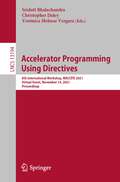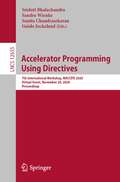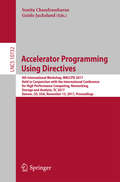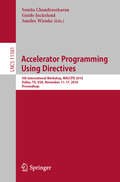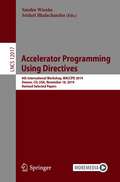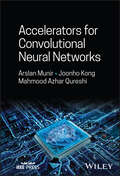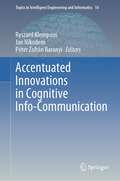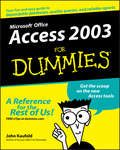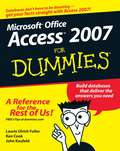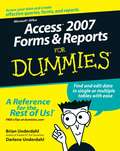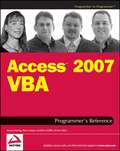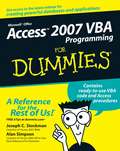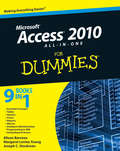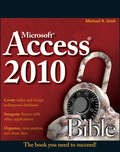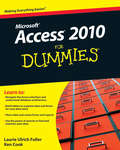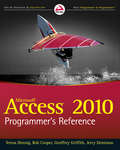- Table View
- List View
Accelerator Programming Using Directives: 8th International Workshop, WACCPD 2021, Virtual Event, November 14, 2021, Proceedings (Lecture Notes in Computer Science #13194)
by Sridutt Bhalachandra Christopher Daley Verónica Melesse VergaraThis book constitutes the proceedings of the 8th International Workshop on Accelerator Programming Using Directives, WACCPD 2021, which took place in November 2021. The conference was held as hybrid event. WACCPD is one of the major forums for bringing together users, developers, and the software and tools community to share knowledge and experiences when programming emerging complex parallel computing systems. The 7 papers presented in this volume were carefully reviewed and selected from 11 submissions. They were organized in topical sections named: Directive Alternatives; Directive Extensions; and Directive Case Studies.
Accelerator Programming Using Directives: 7th International Workshop, WACCPD 2020, Virtual Event, November 20, 2020, Proceedings (Lecture Notes in Computer Science #12655)
by Sridutt Bhalachandra Sandra Wienke Sunita Chandrasekaran Guido JuckelandThis book constitutes the proceedings of the 7th International Workshop on Accelerator Programming Using Directives, WACCPD 2020, which took place on November 20, 2021. The workshop was initially planned to take place in Atlanta, GA, USA, and changed to an online format due to the COVID-19 pandemic.WACCPD is one of the major forums for bringing together users, developers, and the software and tools community to share knowledge and experiences when programming emerging complex parallel computing systems. The 5 papers presented in this volume were carefully reviewed and selected from 7 submissions. They were organized in topical sections named: OpenMP; OpenACC; and Domain-specific Solvers.
Accelerator Programming Using Directives: 4th International Workshop, WACCPD 2017, Held in Conjunction with the International Conference for High Performance Computing, Networking, Storage and Analysis, SC 2017, Denver, CO, USA, November 13, 2017, Proceedings (Lecture Notes in Computer Science #10732)
by Sunita Chandrasekaran Guido JuckelandThis book constitutes the refereed post-conference proceedings of the 4th International Workshop on Accelerator Programming Using Directives, WACCPD 2017, held in Denver, CO, USA, in November 2017.The 9 full papers presented have been carefully reviewed and selected from 14 submissions. The papers share knowledge and experiences to program emerging complex parallel computing systems. They are organized in the following three sections: applications; environments; and program evaluation.
Accelerator Programming Using Directives: 5th International Workshop, WACCPD 2018, Dallas, TX, USA, November 11-17, 2018, Proceedings (Lecture Notes in Computer Science #11381)
by Sunita Chandrasekaran Guido Juckeland Sandra WienkeThis book constitutes the refereed post-conference proceedings of the 5th International Workshop on Accelerator Programming Using Directives, WACCPD 2018, held in Dallas, TX, USA, in November 2018. The 6 full papers presented have been carefully reviewed and selected from 12 submissions. The papers share knowledge and experiences to program emerging complex parallel computing systems. They are organized in the following three sections: applications; using openMP; and program evaluation.
Accelerator Programming Using Directives: 6th International Workshop, WACCPD 2019, Denver, CO, USA, November 18, 2019, Revised Selected Papers (Lecture Notes in Computer Science #12017)
by Sandra Wienke Sridutt BhalachandraThis book constitutes the refereed post-conference proceedings of the 6th International Workshop on Accelerator Programming Using Directives, WACCPD 2019, held in Denver, CO, USA, in November 2019.The 7 full papers presented have been carefully reviewed and selected from 13 submissions. The papers share knowledge and experiences to program emerging complex parallel computing systems. They are organized in the following three sections: porting scientific applications to heterogeneous architectures using directives; directive-based programming for math libraries; and performance portability for heterogeneous architectures.
Accelerators for Convolutional Neural Networks
by Arslan Munir Joonho Kong Mahmood Azhar QureshiAccelerators for Convolutional Neural Networks Comprehensive and thorough resource exploring different types of convolutional neural networks and complementary accelerators Accelerators for Convolutional Neural Networks provides basic deep learning knowledge and instructive content to build up convolutional neural network (CNN) accelerators for the Internet of things (IoT) and edge computing practitioners, elucidating compressive coding for CNNs, presenting a two-step lossless input feature maps compression method, discussing arithmetic coding -based lossless weights compression method and the design of an associated decoding method, describing contemporary sparse CNNs that consider sparsity in both weights and activation maps, and discussing hardware/software co-design and co-scheduling techniques that can lead to better optimization and utilization of the available hardware resources for CNN acceleration. The first part of the book provides an overview of CNNs along with the composition and parameters of different contemporary CNN models. Later chapters focus on compressive coding for CNNs and the design of dense CNN accelerators. The book also provides directions for future research and development for CNN accelerators. Other sample topics covered in Accelerators for Convolutional Neural Networks include: How to apply arithmetic coding and decoding with range scaling for lossless weight compression for 5-bit CNN weights to deploy CNNs in extremely resource-constrained systems State-of-the-art research surrounding dense CNN accelerators, which are mostly based on systolic arrays or parallel multiply-accumulate (MAC) arrays iMAC dense CNN accelerator, which combines image-to-column (im2col) and general matrix multiplication (GEMM) hardware acceleration Multi-threaded, low-cost, log-based processing element (PE) core, instances of which are stacked in a spatial grid to engender NeuroMAX dense accelerator Sparse-PE, a multi-threaded and flexible CNN PE core that exploits sparsity in both weights and activation maps, instances of which can be stacked in a spatial grid for engendering sparse CNN accelerators For researchers in AI, computer vision, computer architecture, and embedded systems, along with graduate and senior undergraduate students in related programs of study, Accelerators for Convolutional Neural Networks is an essential resource to understanding the many facets of the subject and relevant applications.
Accelerators for Convolutional Neural Networks
by Arslan Munir Joonho Kong Mahmood Azhar QureshiAccelerators for Convolutional Neural Networks Comprehensive and thorough resource exploring different types of convolutional neural networks and complementary accelerators Accelerators for Convolutional Neural Networks provides basic deep learning knowledge and instructive content to build up convolutional neural network (CNN) accelerators for the Internet of things (IoT) and edge computing practitioners, elucidating compressive coding for CNNs, presenting a two-step lossless input feature maps compression method, discussing arithmetic coding -based lossless weights compression method and the design of an associated decoding method, describing contemporary sparse CNNs that consider sparsity in both weights and activation maps, and discussing hardware/software co-design and co-scheduling techniques that can lead to better optimization and utilization of the available hardware resources for CNN acceleration. The first part of the book provides an overview of CNNs along with the composition and parameters of different contemporary CNN models. Later chapters focus on compressive coding for CNNs and the design of dense CNN accelerators. The book also provides directions for future research and development for CNN accelerators. Other sample topics covered in Accelerators for Convolutional Neural Networks include: How to apply arithmetic coding and decoding with range scaling for lossless weight compression for 5-bit CNN weights to deploy CNNs in extremely resource-constrained systems State-of-the-art research surrounding dense CNN accelerators, which are mostly based on systolic arrays or parallel multiply-accumulate (MAC) arrays iMAC dense CNN accelerator, which combines image-to-column (im2col) and general matrix multiplication (GEMM) hardware acceleration Multi-threaded, low-cost, log-based processing element (PE) core, instances of which are stacked in a spatial grid to engender NeuroMAX dense accelerator Sparse-PE, a multi-threaded and flexible CNN PE core that exploits sparsity in both weights and activation maps, instances of which can be stacked in a spatial grid for engendering sparse CNN accelerators For researchers in AI, computer vision, computer architecture, and embedded systems, along with graduate and senior undergraduate students in related programs of study, Accelerators for Convolutional Neural Networks is an essential resource to understanding the many facets of the subject and relevant applications.
Accentuated Innovations in Cognitive Info-Communication (Topics in Intelligent Engineering and Informatics #16)
by Ryszard Klempous Jan Nikodem Péter Zoltán BaranyiConsidering the emergence of artificial intelligence, virtual and augmented reality, 3D video and television, and holography, it is logical that we should also begin to create applications and businesses driven by these technologies. The 12 chapters of Accentuated Innovations in Cognitive Info-Communication focus on the research and development of state-of-the-art information in Cognitive Info-Communication. This interdisciplinary research area has emerged as a synergy between Info-Communication and Cognitive Sciences. It presents a synthetic, holistic combination of coherent technologies that will become increasingly important in the coming decade. It is a teaching and reference guide for VR, robotics, virtual classrooms and institutions, and medicine at the undergraduate and postgraduate levels. The discussed book is an immersive learning experience for students and teachers worldwide. In addition, it applies to other fields such as healthcare, performing arts, and television.
Access 2003 For Dummies (For Dummies Ser.)
by John KaufeldWhen you hear the word “database,” do your eyes glaze over? Does the mention of fields and tables make your blood pressure skyrocket? Does the idea of entering and using hyperlinks make you hyperventilate? Whether you’re running a business or a household . . . whether you need to be able to quickly access customer information, your recipe for chicken cacciatore, or the Little League team’s records, Access 2003 holds the key. This friendly guide unlocks the secrets of using Access 2003 to store, manage, organize, reorganize, and use data! It gives you: The basics of the whole database concept Suggestions for solving problems with Access What you need to know to design, build, use, and change Access tables Info on the ten most common types of fields The scoop on using queries to unearth the answers hiding somewhere in your data Guidelines for using the Access report system to make short work of long, previously time-consuming, reports In the relaxed, comfortable For Dummies style, this book has easy-to-follow, step-by-step instructions and lots of screen shots. If you want to create and manage a database for a huge auction house, this guide will get you going . . . going . . . gone. If you want to create a database for your music collection, it gives you the score then shows you how to use formatting and add graphics to jazz it up. You’ll get the low-down on extracting all kinds of information from databases and putting that information to practical use. You’ll discover how to: Use Label Wizard to create mailing labels, file labels, shipping labels, or name tags Use Chart Wizard to create line charts, bar, cone, and column charts, pie and donut charts, area charts, and XY and bubble charts Use Auto Reports to create columnar or tabular reports and then fine-tune them Export reports to Microsoft Word and Excel Get your data Web-ready and put it on the Internet in either static or dynamic form Build forms with Form Wizard And speaking of high-tech fun, Access 2003 For Dummies even tells you how to install and use speech recognition software with Access 2003. So if the idea of working with databases has you talking to yourself, this is just the book you need.
Access 2003 For Dummies
by John KaufeldWhen you hear the word “database,” do your eyes glaze over? Does the mention of fields and tables make your blood pressure skyrocket? Does the idea of entering and using hyperlinks make you hyperventilate? Whether you’re running a business or a household . . . whether you need to be able to quickly access customer information, your recipe for chicken cacciatore, or the Little League team’s records, Access 2003 holds the key. This friendly guide unlocks the secrets of using Access 2003 to store, manage, organize, reorganize, and use data! It gives you: The basics of the whole database concept Suggestions for solving problems with Access What you need to know to design, build, use, and change Access tables Info on the ten most common types of fields The scoop on using queries to unearth the answers hiding somewhere in your data Guidelines for using the Access report system to make short work of long, previously time-consuming, reports In the relaxed, comfortable For Dummies style, this book has easy-to-follow, step-by-step instructions and lots of screen shots. If you want to create and manage a database for a huge auction house, this guide will get you going . . . going . . . gone. If you want to create a database for your music collection, it gives you the score then shows you how to use formatting and add graphics to jazz it up. You’ll get the low-down on extracting all kinds of information from databases and putting that information to practical use. You’ll discover how to: Use Label Wizard to create mailing labels, file labels, shipping labels, or name tags Use Chart Wizard to create line charts, bar, cone, and column charts, pie and donut charts, area charts, and XY and bubble charts Use Auto Reports to create columnar or tabular reports and then fine-tune them Export reports to Microsoft Word and Excel Get your data Web-ready and put it on the Internet in either static or dynamic form Build forms with Form Wizard And speaking of high-tech fun, Access 2003 For Dummies even tells you how to install and use speech recognition software with Access 2003. So if the idea of working with databases has you talking to yourself, this is just the book you need.
Access 2007 For Dummies (For Dummies Computers Ser.)
by Laurie A. Ulrich Ken Cook John KaufeldReduce stress with timesaving database shortcuts Explore database basics and build tables and reports that corral your data Access has undergone an extreme makeover! Whether you've used one of the older versions or this is your first exposure to Access, here's where you'll find the essentials you need to make this database system work for you. Cruise around the new interface, team up Access with other Office applications, use wizards to automate your work, and much more. Discover how to Create a new Access database Import and export data Build forms for efficient data entry Search tables for specific data Construct custom reports Customize your database navigation
Access 2007 For Dummies
by Laurie A. Ulrich Ken Cook John KaufeldReduce stress with timesaving database shortcuts Explore database basics and build tables and reports that corral your data Access has undergone an extreme makeover! Whether you've used one of the older versions or this is your first exposure to Access, here's where you'll find the essentials you need to make this database system work for you. Cruise around the new interface, team up Access with other Office applications, use wizards to automate your work, and much more. Discover how to Create a new Access database Import and export data Build forms for efficient data entry Search tables for specific data Construct custom reports Customize your database navigation
Access 2007 Forms and Reports For Dummies
by Brian Underdahl Darlene UnderdahlDo you have tons and tons of data on your computer but you’re not quite sure how to make heads or tails of them—or even organize them? Are you using Access as spreadsheet rather than what it was really meant for? If you have trouble finding meaning in your data, then Access 2007 Forms & Reports for Dummies let you discover the wonders of this highly useful program. This no-nonsense guide gets right down to business by showing you the easy way to use this powerful tool. It gets you started with selective, targeted queries; forms that improve efficiency; and reports that communicate—while sparing you of any fancy language. This hands-on guide features clear, concise instructions that show you how to: Orient yourself with forms and reports Create and modify queries Build and edit forms Design and update reports Troubleshoot queries, forms, and reports Make your forms useful Add multiple tables to forms Add finishing touches to reports Thanks to the included references, Web sites, and informative tips, putting your data to good use has never been easier. You’ll even add some pizzazz to your reports with handy suggestions on ways to wow your viewers. With Access 2007 Forms & Reports for Dummies, you will be creating effective queries, forms, and reports in no time!
Access 2007 Forms and Reports For Dummies
by Brian Underdahl Darlene UnderdahlDo you have tons and tons of data on your computer but you’re not quite sure how to make heads or tails of them—or even organize them? Are you using Access as spreadsheet rather than what it was really meant for? If you have trouble finding meaning in your data, then Access 2007 Forms & Reports for Dummies let you discover the wonders of this highly useful program. This no-nonsense guide gets right down to business by showing you the easy way to use this powerful tool. It gets you started with selective, targeted queries; forms that improve efficiency; and reports that communicate—while sparing you of any fancy language. This hands-on guide features clear, concise instructions that show you how to: Orient yourself with forms and reports Create and modify queries Build and edit forms Design and update reports Troubleshoot queries, forms, and reports Make your forms useful Add multiple tables to forms Add finishing touches to reports Thanks to the included references, Web sites, and informative tips, putting your data to good use has never been easier. You’ll even add some pizzazz to your reports with handy suggestions on ways to wow your viewers. With Access 2007 Forms & Reports for Dummies, you will be creating effective queries, forms, and reports in no time!
Access 2007 VBA Programmer's Reference
by Teresa Hennig Rob Cooper Geoffrey L. Griffith Armen SteinAccess 2007 VBA Programmer's Reference covers a wide spectrum of programming topics relevant to Access. Although it assumes the reader has some familiarity with VBA programming language, it begins with a brief introduction to VBA. And to help you leverage the tools that Access provides, a chapter highlights the new features in Microsoft Office Access 2007 — including new wizards and GUI (graphical user interface) elements that previously required VBA code, as well as new VBA features. The book also discusses how to create and name variables, how to use Data Access Object (DAO) and ActiveX Data Object (ADO) to manipulate data both within Access and within other applications, proper error handling techniques, and advanced functions such as creating classes and using APIs. Key new objects such as using Macros and the Ribbon are explored, too, as are forms and reports, the two most powerful tools for working with and displaying data. Working with other applications is covered extensively both in a general nature and for working specifically with Microsoft Office applications, Windows SharePoint Services, and SQL Server. Of course, this book wouldn’t be complete without discussing security issues and the Developer Extensions.
Access 2007 VBA Programmer's Reference
by Teresa Hennig Rob Cooper Geoffrey L. Griffith Armen SteinAccess 2007 VBA Programmer's Reference covers a wide spectrum of programming topics relevant to Access. Although it assumes the reader has some familiarity with VBA programming language, it begins with a brief introduction to VBA. And to help you leverage the tools that Access provides, a chapter highlights the new features in Microsoft Office Access 2007 — including new wizards and GUI (graphical user interface) elements that previously required VBA code, as well as new VBA features. The book also discusses how to create and name variables, how to use Data Access Object (DAO) and ActiveX Data Object (ADO) to manipulate data both within Access and within other applications, proper error handling techniques, and advanced functions such as creating classes and using APIs. Key new objects such as using Macros and the Ribbon are explored, too, as are forms and reports, the two most powerful tools for working with and displaying data. Working with other applications is covered extensively both in a general nature and for working specifically with Microsoft Office applications, Windows SharePoint Services, and SQL Server. Of course, this book wouldn’t be complete without discussing security issues and the Developer Extensions.
Access 2007 VBA Programming For Dummies
by Joseph C. Stockman Alan SimpsonIf you’ve been using Access for a while, you’re probably aware of its power and potential and itching to take advantage of both. Access 2007 VBA Programming For Dummies takes you beyond forms and reports and shows you how to use VBA to create killer Access databases and applications. This gentle introduction to VBA programming covers everything you need to get started, including: Basic programming skills and concepts Explanations of modules, procedures, objects, and arguments Access-unique programming activities, including SQL and recordsets How to use the Visual Basic editor Creating dialog boxes, lists, drop-down menus, and functions Integrating with other Office applications Ready-to-use VBA code examples to type in or copy and paste from the Web Completely revised to reflect all changes found in Microsoft Access 2007, Access 2007 VBA Programming For Dummies gives you access to Access like you’ve never had it before.
Access 2007 VBA Programming For Dummies
by Joseph C. Stockman Alan SimpsonIf you’ve been using Access for a while, you’re probably aware of its power and potential and itching to take advantage of both. Access 2007 VBA Programming For Dummies takes you beyond forms and reports and shows you how to use VBA to create killer Access databases and applications. This gentle introduction to VBA programming covers everything you need to get started, including: Basic programming skills and concepts Explanations of modules, procedures, objects, and arguments Access-unique programming activities, including SQL and recordsets How to use the Visual Basic editor Creating dialog boxes, lists, drop-down menus, and functions Integrating with other Office applications Ready-to-use VBA code examples to type in or copy and paste from the Web Completely revised to reflect all changes found in Microsoft Access 2007, Access 2007 VBA Programming For Dummies gives you access to Access like you’ve never had it before.
Access 2010 All-in-One For Dummies
by Alison Barrows Margaret Levine Young Joseph C. StockmanThe all-in-one reference to all aspects of Microsoft Access 2010 If you want to learn Microsoft Access inside and out, the nine minibooks in this easy-access reference are exactly what you need. Read the book cover to cover, or jump into any of the minibooks for the instruction and topics you need most. Learn how to connect Access to SQL Server, manipulate your data locally, use nifty new features from Office 2010 such as the enhanced Ribbon, create queries and macros like a champ, and much more. From the basics to advanced functions, it’s what you need to make Access more accesssible. Shows you how to store, organize, view, analyze, and share data using Microsoft Access 2010, the database application included with Microsoft Office 2010 Includes nine minibooks that cover such topics as database design, tables, queries, forms, reports, macros, database administration, securing data, programming with Visual Basic for Applications (VBA), and using Access with the Web Helps you build database solutions that integrate with the Web and other enterprise data sources Offers plenty of techniques, tips, and tricks to help you get the most out of Access This all-in-one guide contains everything you need to start power-using Access 2010!
Access 2010 All-in-One For Dummies
by Alison Barrows Margaret Levine Young Joseph C. StockmanThe all-in-one reference to all aspects of Microsoft Access 2010 If you want to learn Microsoft Access inside and out, the nine minibooks in this easy-access reference are exactly what you need. Read the book cover to cover, or jump into any of the minibooks for the instruction and topics you need most. Learn how to connect Access to SQL Server, manipulate your data locally, use nifty new features from Office 2010 such as the enhanced Ribbon, create queries and macros like a champ, and much more. From the basics to advanced functions, it’s what you need to make Access more accesssible. Shows you how to store, organize, view, analyze, and share data using Microsoft Access 2010, the database application included with Microsoft Office 2010 Includes nine minibooks that cover such topics as database design, tables, queries, forms, reports, macros, database administration, securing data, programming with Visual Basic for Applications (VBA), and using Access with the Web Helps you build database solutions that integrate with the Web and other enterprise data sources Offers plenty of techniques, tips, and tricks to help you get the most out of Access This all-in-one guide contains everything you need to start power-using Access 2010!
Access 2010 Bible: Excel 2010 Bible, Access 2010 Bible, Powerpoint 2010 Bible, Word 2010 Bible (Bible #695)
by Michael R. GrohThe expert guidance you need to get the most out of Access 2010 Get the Access 2010 information you need to succeed with this comprehensive reference. If this is your first encounter with Access, you'll appreciate the thorough attention to database fundamentals and terminology. If you're familiar with earlier versions, you can jump right into Access 2010 enhancements such as the new Access user interface and wider use of XML and Web services. Takes you under the hood of Microsoft Access 2010, the database application included with Microsoft Office 2010 Explores the latest enhancements, such as a new user interface and wider use of XML and Web services; also, how to exchange data with Word, Excel, PowerPoint, and other Office apps Covers how to create tables, manipulate datasheets, and work with multiple tables Explains the seven database objects and how to use a seven-step design method to build a database tailored to your needs Shows you how to build forms, use Visual Basic and the VBA Editor, automate query parameters, create functions and subroutines, use XML to create data access pages, and more Includes a CD with all source code from the book and working examples, plus bonus shareware, freeware, trial, demo and evaluation programs that work with or enhance Microsoft Office You’ll want to keep this soup-to-nuts Access reference close at hand! Note: CD-ROM/DVD and other supplementary materials are not included as part of eBook file.
Access 2010 Bible (Bible #695)
by Michael R. GrohThe expert guidance you need to get the most out of Access 2010 Get the Access 2010 information you need to succeed with this comprehensive reference. If this is your first encounter with Access, you'll appreciate the thorough attention to database fundamentals and terminology. If you're familiar with earlier versions, you can jump right into Access 2010 enhancements such as the new Access user interface and wider use of XML and Web services. Takes you under the hood of Microsoft Access 2010, the database application included with Microsoft Office 2010 Explores the latest enhancements, such as a new user interface and wider use of XML and Web services; also, how to exchange data with Word, Excel, PowerPoint, and other Office apps Covers how to create tables, manipulate datasheets, and work with multiple tables Explains the seven database objects and how to use a seven-step design method to build a database tailored to your needs Shows you how to build forms, use Visual Basic and the VBA Editor, automate query parameters, create functions and subroutines, use XML to create data access pages, and more Includes a CD with all source code from the book and working examples, plus bonus shareware, freeware, trial, demo and evaluation programs that work with or enhance Microsoft Office You’ll want to keep this soup-to-nuts Access reference close at hand! Note: CD-ROM/DVD and other supplementary materials are not included as part of eBook file.
Access 2010 For Dummies
by Laurie A. Ulrich Ken CookA friendly, step-by-step guide to the Microsoft Office database application Access may be the least understood and most challenging application in the Microsoft Office suite. This guide is designed to help anyone who lacks experience in creating and managing a database learn to use Access 2010 quickly and easily. In the classic For Dummies tradition, the book provides an education in Access, the interface, and the architecture of a database. It explains the process of building a database, linking information, sharing data, generating reports, and much more. As the Microsoft Office database application, Access may be the least understood and most challenging part of the Office suite Access 2010 For Dummies walks newcomers through building and using their first database Covers linking information in a database, setting relationships, modeling data, and building tables Explores how to extract data from Access and get specific answers, create forms, and export data in reports A section for more experienced users looks at analyzing errors and creating an interface Fully updated for the newest version, Access 2010 For Dummies gets new Access users up to speed and helps veterans get the most from the Office database application.
Access 2010 For Dummies
by Laurie A. Ulrich Ken CookA friendly, step-by-step guide to the Microsoft Office database application Access may be the least understood and most challenging application in the Microsoft Office suite. This guide is designed to help anyone who lacks experience in creating and managing a database learn to use Access 2010 quickly and easily. In the classic For Dummies tradition, the book provides an education in Access, the interface, and the architecture of a database. It explains the process of building a database, linking information, sharing data, generating reports, and much more. As the Microsoft Office database application, Access may be the least understood and most challenging part of the Office suite Access 2010 For Dummies walks newcomers through building and using their first database Covers linking information in a database, setting relationships, modeling data, and building tables Explores how to extract data from Access and get specific answers, create forms, and export data in reports A section for more experienced users looks at analyzing errors and creating an interface Fully updated for the newest version, Access 2010 For Dummies gets new Access users up to speed and helps veterans get the most from the Office database application.
Access 2010 Programmer's Reference
by Teresa Hennig Rob Cooper Geoffrey L. Griffith Jerry DennisonA comprehensive guide to programming for Access 2010 and 2007 Millions of people use the Access database applications, and hundreds of thousands of developers work with Access daily. Access 2010 brings better integration with SQL Server and enhanced XML support; this Wrox guide shows developers how to take advantage of these and other improvements. With in-depth coverage of VBA, macros, and other programming methods for building Access applications, this book also provides real-world code examples to demonstrate each topic. Access 2010 Programmer's Referenceis a comprehensive guide to the best-of-breed techniques for programming Access applications. Coverage Includes: Introduction to Microsoft Access 2010 New Features Upgrading and Converting to Access 2010 Macros in Access 2010 Using the VBA Editor VBA Basics Using VBA in Access Creating Classes in VBA Extending VBA with APIs Working with the Windows Registry Using DAO to Access Data Using ADO to Access Data Using SQL with VBA Using VBA to Enhance Forms Enhancing Reports with VBA Customizing the Ribbon Customizing the Office Backstage Working with Office 2010 Working with SharePoint Working with .NET Building Client-Server Applications with Access The Access 2010 Templates Access Runtime Deployment Database Security Access 2010 Security Features
